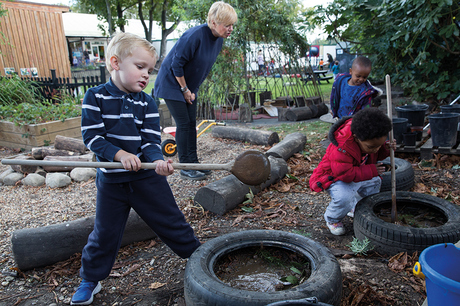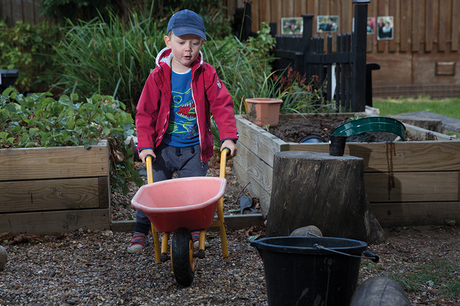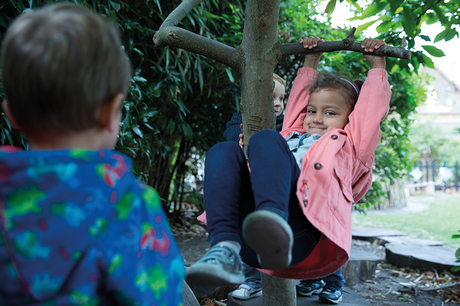
Outdoors and Active – an action research project led by the London Borough of Newham – has taken early years practitioners on an eight-month exploration of movement in two- and three-year-olds, generating intriguing discoveries and practical, realistic changes to nursery routines, resources and risk-taking.
The aim of the project was to tackle the shocking and seemingly inexorable increase in obesity in children, and it involved 20 practitioners from nurseries, schools, PVI settings and children’s centres.
Over the course of the project, they explored:
- what high-quality physicality is
- how we can plan for it
- what kind of outdoor places and resources support it
- how we can encourage parents and carers to be more active and more playful with their children.
- Partnering with Early Education, and using Jan White’s book Every Child A Mover as a source text, a thought-provoking and pragmatic programme emerged, consisting of practical workshops, visits to one another’s settings and to local parks and a 20-week, peer-supported action research assignment.
Now complete, Newham aims to share the programme’s outcomes, providing simple, cost-effective ways of maximising opportunities to get children outdoors and active.

PHYSICALITY AND PHYSICAL DEVELOPMENT
The programme began by examining the difference between ‘physicality’ and ‘physical development’. The latter, we agreed, involves milestones and skills that children can be expected to acquire as they grow older. Physicality is the state of being physical.
Proprioceptive and vestibular senses
Examining these ideas required Outdoors and Active participants to examine children’s proprioceptive and vestibular senses:
The vestibular system determines our ability to balance and move in a controlled way. The vestibular fluid in the inner ear is thinner in children than in adults and is one reason why they seem to get less dizzy than adults.
Proprioception relates to our sense of self-knowing where our bodies ‘are’ in space. The proprioceptive sense is intuitive and allows children to control and manage their movements.
As a project team, we were keen to explore these senses in more detail, since their crucial role in developing children’s physical capabilities can often be misunderstood or overlooked. In particular, the concept of children being ‘in touch with’ their bodies – understanding what they can do and what the potential of their body is – is not easily served by standard outdoor play equipment, which tends towards the physical development model, rather than the proprioceptive.
Evidence and audit
Initial reading for the project participants helped them understand more about the ‘seven’ senses: sight, hearing, taste, smell, touch and vestibular and proprioceptive systems.
Every Child A Mover in particular reminded us to think about the joy of movement that children experience, and reinforced the well-known and documented connections between movement and cognition, and movement and well-being.
This allowed the group to reflect on their own setting’s outdoor provision for movement, using Jasmine Pasch’s Boing Whoosh RolyPoly approach and Play Learning Life’s outdoor space auditing tools.
The CPD sessions within the project were hosted by a different school each time, which afforded opportunities to examine what physicality can look like in a set of contrasting environments, and with children of different ages. Revisiting the audit tool while observing children at play in each school playground added valuable evidence to help shape participants’ own action research queries.
Range of movements
Through these early stages of the project, participants were able to decide on the range of movements that they wanted to consider, and it was agreed that they would focus on how to encourage children to:
- be physical
- make big movements
- work on their upper body strength
- use those big muscle groups in the back and thighs.
Range of resources
What emerged was a ‘hit list’ of interventions to promote physicality and sensory processing, with participants studying these further in their action research projects:
- Different types of surfacing and level changes (including mounds, steps and uneven surfaces) to encourage stability and risk taking
- Accessible storage to encourage children to lift resources out, transport them around the space – and put them away!
- Climbing features (equipment, ladders, trees…) for upper-body strength and resilience
- Open spaces to run, roll, whoosh, twirl and leap through
- Provision of large objects, heavy objects, awkwardly shaped objects, outsized objects for challenge and interest.

Boing Whoosh RolyPoly
During the project, the cohort made great use of Jasmine Pasch’s ‘Boing Whoosh RolyPoly’ approach to help practitioners organise their thinking and focus their efforts on children’s vestibular and balance movements.
The phrase is easy to recall (and interpret) and immediately conjures up precisely the kind of movements we are aiming to encourage:
Boing: ‘Up and down movements in a vertical axis,’ says Jasmine. Babies and toddlers bouncing on an adult knee, being tossed into the air and caught, bouncing on the bed and simply being lifted up and down are all early forms of ‘boing’. Independently mobile children will find this bounciness in hanging upside down, climbing and jumping from height, hopping and skipping, trampolining and springing up.
Whoosh: ‘To and fro movements such as being rocked from side to side’ introduce very young children to ‘whooshing’, explains Jasmine. Older children will enjoy rocking and spring toys in the playground, swings and zip wires, wheely toys and slides, and simply running with the wind in their hair.
RolyPoly: ‘Movement where the body rotates’ is Jasmine’s description of RolyPoly. Spinning and twirling are among young children’s favourite movements and are crucial for their balance, co-ordination, and core strength. Somersaults and rolling down a mound are complex body movements that require control and courage to perform and are important milestones in children’s overall physical development.

CASE STUDY: EDITH KERRISON NURSERY AND CHILDREN’S CENTRE
The first Outdoors and Active workshop was hosted by Edith Kerrison Nursery and Children’s Centre, where the garden enables children to explore and test their bodies using built and natural features to create physical challenges.
Deputy head teacher Jo Aylett took our group on a tour of the large and varied outdoor space. A covered transition area immediately outside the rooms is richly resourced with loose parts such as hollow blocks, sofas, art and craft materials, small-world resources and a mud kitchen, creating small, personal spaces for children to relax and collaborate in.
By contrast, the main garden is extensive and uncluttered and provides opportunities for running, rolling, ball games, parachute play and games that help children become ‘puffed out’. Children are able to range freely all over the space, choosing construction or gardening or sand play or transporting, as the fancy takes them.
Using heavy, awkwardly shaped or wheeled equipment – such as wheelbarrows, tools and trolleys – helps young children at Edith Kerrison develop an awareness of the extent of their own bodies and a sense of how they can then operate within a space.
Jo says, ‘Our two-years-olds spend the most time outside, where their progress in gaining control of their bodies and movements is very clear. The outdoors gives them far greater challenge in terms of balance and co-ordination and the opportunities it gives for big movements and more boisterous play.’
The nursery provides good-quality outdoor clothing, meaning the weather never prevents children getting active and physical. The other crucial component, explains Jo, is ‘enabling adults who truly understand the importance of physical play for children, giving children the ability to get messy, to jump in and out and over puddles and to climb, crawl, slide, jump, spin and swing – gaining stronger muscles and bodies in the process.’
MORE INFORMATION
- Every Child A Mover by Jan White (Early Education, 2015)
- The Out-of-Sync Child Has Fun by Carol Stock Kranowitz (Penguin, 2003)
- ‘Physical Development – Move On!’ by Anne O’Connor, Nursery World, 29 June 2015
- ‘All About… Sensory Development’ by Anne O’Connor, Nursery World, 9 February 2015
- British Heart Foundation guidance on physical activity for walkers (www.tinyurl.com/BHFwalkers) and for non-walkers (www.tinyurl.com/BHFnonwalkers)
- Jasmine Pasch, www.jasminepasch.co.uk









